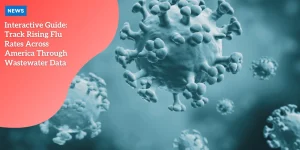The Truth About COVID Surface Transmission: What You Need to Know
Around the globe, a new strain of COVID-19 named the XEC variant is spreading rapidly.
Anúncios
Originating from the KS.1.1 and KP.3.3 strains, the XEC variant was first detected in Europe earlier this year and has now reached the US.
Dr. Maria Torriani, an infectious disease specialist with UC San Diego Health, notes, “We expect this could become the next dominant variant.”
Health officials are gearing up for a potential increase in COVID-19 cases this fall due to the emergence of the XEC variant.
Anúncios
Like its predecessors, the XEC variant primarily spreads through respiratory particles.
This means that exposure is most likely to occur when you’re in close proximity to an infected individual.
When an infected person talks, coughs, or sneezes, they release droplets and aerosols containing respiratory fluids into the air.
Anúncios
These particles can be inhaled through the nose or mouth or potentially enter through the eyes, leading to infection.
An important characteristic of the XEC variant, like other COVID-19 strains, is that particles can linger in the air for several minutes to hours.
This airborne nature means that transmission at distances greater than 6 feet is possible, especially in poorly ventilated environments.
Dr. Nezar Dahdal of Banner Thunderbird Medical Center emphasizes that improving ventilation can help reduce the risk of airborne transmission.
Whether through natural airflow by opening windows or using mechanical ventilation systems, increasing air turnover can significantly lower the concentration of virus particles in the air.
As the medical community closely monitors the situation, understanding the XEC variant’s transmission and taking proactive measures can help mitigate its spread.
Primary Transmission Methods
One key aspect of understanding the XEC variant of COVID-19 is recognizing its primary transmission methods.
Similar to other strains, the XEC variant primarily spreads through respiratory particles.
When an infected person talks, coughs, or sneezes, they release droplets and aerosols into the air.
Close Proximity Risks
Being in close proximity to someone infected significantly increases the risk of catching COVID-19.
This is because respiratory droplets are most concentrated near the person emitting them.
Hence, the closer you are to an infected individual, the higher the likelihood of inhaling these infectious particles.
According to UC San Diego Health, this makes indoor settings, especially those that are crowded or poorly ventilated, particularly hazardous.
Transmission Beyond Six Feet
Interestingly, respiratory particles do not always settle quickly.
They can remain suspended in the air for minutes to hours, depending on ventilation and other environmental factors.
This means that even at distances greater than six feet, there is still a possibility of transmission.
The United States Environmental Protection Agency highlights that improving ventilation can help reduce the concentration of lingering viral particles, thereby lowering the risk of transmission.
As we delve deeper into navigating life amidst the ongoing pandemic, it becomes critical to understand not just how these particles move but also how long they can persist on different surfaces.
Surface Transmission: Facts and Risks
Reduced Risk Compared to Respiratory Transmission
While the XEC variant of COVID-19 is primarily spread through respiratory particles, it’s important to understand the potential, though lower, risk posed by surface transmission.
Experts emphasize that touching contaminated surfaces and then touching your face can lead to infection but is considerably less common compared to inhaling infected droplets UC San Diego Health.
Virus Survival on Different Surfaces
The XEC variant, like other strains, can survive on various materials for different lengths of time.
On surfaces such as glass, steel, and plastic, the virus can remain viable for one to five days.
Cardboard surfaces can harbor the virus for up to one day, while on wood, the virus may persist for up to four days.
Touching contaminated surfaces poses a risk if the virus is transferred to mucous membranes—nose, mouth, or eyes.
This highlights the importance of regular handwashing and avoiding face-touching. Ensuring frequent surface sanitization helps mitigate these risks.
With surface transmission being less common, maintaining hand hygiene and regular sanitization are key defenses against potential infection.
Maintaining good hygiene and being vigilant about cleaning surfaces are crucial preventive measures.
Airborne Transmission Considerations
When it comes to airborne transmission, the XEC variant of COVID-19 poses significant risks.
COVID-19 particles can linger in the air for anywhere from a few minutes to several hours.
This can happen after an infected person talks, coughs, or sneezes.
These microscopic particles can remain suspended, especially in closed or poorly ventilated spaces.
The Role of Ventilation
Ventilation is a crucial factor in the airborne spread of COVID-19. When the air isn’t circulating well, viral particles accumulate and increase the risk of inhalation by others.
On the flip side, good ventilation systems or simply opening windows can significantly reduce the concentration of viral particles in the air.
This means lower chances for anyone in that space to inhale the virus and get infected.
Indoor vs. Outdoor Risks
The risk of airborne transmission of COVID-19 is notably higher indoors compared to outdoors.
In enclosed spaces, especially those with poor ventilation, viral particles can persist in the air for extended periods, presenting a higher risk.
Outdoors, natural air currents help disperse these particles, making it less likely for someone to inhale a dangerous amount.
Understanding these considerations about airborne transmission can guide us in creating safer environments, whether we’re at home, at work, or out in public.
Prevention Strategies
Regular Handwashing and Surface Sanitization
Ensuring regular handwashing is one of the simplest yet most effective ways to minimize the risk of XEC variant infection.
The virus might not survive long on surfaces without a host, but it can persist on various materials like glass and plastic for up to five days.
Frequent handwashing with soap and water or using hand sanitizers significantly reduces this risk. Furthermore, surface sanitization is vital.
By wiping down countertops, doorknobs, and other frequently touched surfaces, you decrease the chance of transferring the virus from those surfaces to your face, where it can enter your body.
Wearing Masks and Keeping Vaccinations Up-to-Date
Masks act as a barrier, preventing respiratory particles from both entering and leaving your airways.
Whether you are in close proximity to others or in poorly ventilated spaces, masks are crucial in reducing transmission.
Additionally, staying up-to-date with vaccinations can provide an added layer of defense.
The latest vaccines target various circulating variants, offering protection and reducing the risk of severe complications in case of infection.
Improving Ventilation by Opening Windows or Spending Time Outdoors
Having good ventilation is essential in mitigating airborne transmission.
COVID-19 particles can linger in the air for extended periods, especially in enclosed spaces.
Enhancing air circulation by opening windows or using air purifiers can help in dispersing these particles.
Spending more time outdoors where air circulation is naturally better also reduces the risk.
By incorporating these preventive measures into daily routines, individuals can significantly lower their risk of contracting the XEC variant and help curb its spread.
Living with COVID-Positive Individuals
Living with someone who has tested positive for COVID-19, especially the XEC variant, can be daunting.
However, avoiding infection is possible even in close quarters.
Key factors such as immune system strength, the specific variant, and hygiene practices play a significant role in reducing transmission risk.
Possibility of Avoiding Infection Despite Close Contact
Surprisingly, it is possible to escape infection while living with a COVID-positive individual.
Following proactive protection measures can significantly minimize risk. Regularly washing hands, sanitizing surfaces, and wearing masks are critical practices.
Dr. Nezar Dahdal stresses that these simple steps can drastically reduce exposure by eliminating viral particles that may settle on surfaces or linger in the air.
Factors Affecting Transmission
Several key factors influence the likelihood of COVID-19 transmission in a household:
- Immune System: A robust immune system can potentially fend off infections better. Immunocompromised individuals or those with underlying health conditions must be extra cautious.
- Variant Behavior: Some variants, like the XEC variant, may have higher transmission rates. Understanding the nature of the variant can help in tailoring preventive measures accordingly.
- Hygiene Practices: Consistent hygiene practices such as handwashing, regular surface cleaning, and mask-wearing are crucial. Good hygiene can prevent the virus from transferring from surfaces to mucous membranes, thus entering the body Cleveland Clinic.
Importance of Proactive Protection Measures
Proactively adopting preventive measures is crucial. Washing hands frequently and avoiding touching the face are basic but effective steps.
Utilizing disinfectants to clean commonly-touched surfaces, such as door handles and countertops, can further reduce the risk.
Staying updated with vaccinations is another layer of protection. National health guidelines recommend vaccination as it provides coverage against circulating variants, including potentially the XEC variant.
Improving ventilation by keeping windows open or spending more time outdoors decreases the concentration of airborne virus particles.
This measure not only protects individuals but also helps maintain a healthier living environment for everyone in the household.
By implementing these strategies, it’s possible to coexist with a COVID-positive individual while minimizing the risk of transmission.





